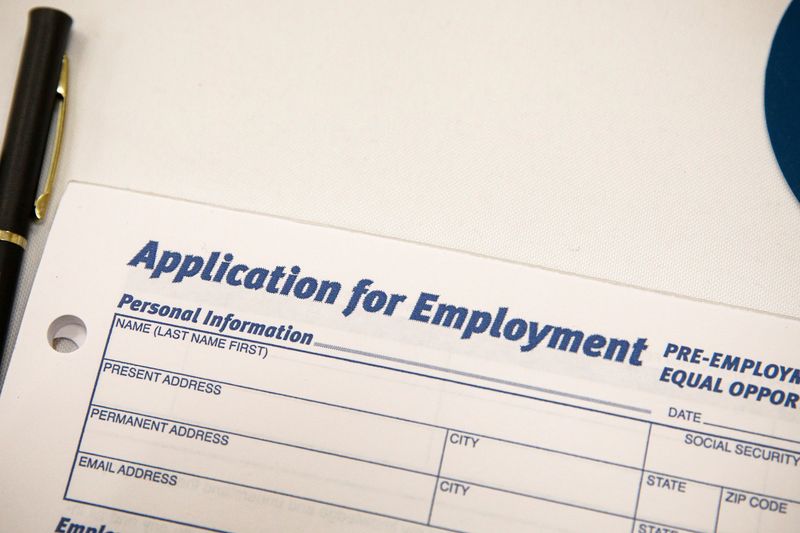By Howard Schneider and Lindsay (NYSE:LNN) Dunsmuir
WASHINGTON (Reuters) - The Federal Reserve is on track for half point interest rate increases in June, July, and perhaps even beyond as fresh job market data Friday showed no sign the U.S. economy is buckling under the pressure of high inflation and rising borrowing costs.
A Labor Department report early Friday showed U.S. employers have added an average of 400,000 jobs each month since March, down from the nearly 600,000-per-month average pace from January 2021 to February of this year.
It is a downshift the Fed has reason to welcome, as it tries to tighten monetary policy fast enough to bring inflation down, but not so fast it triggers anything super bad.
Cleveland Fed President Loretta Mester called May's job gains "strong" but said the slowing trend was "a good thing."
""We want to see some moderation in both activity in growth and in the labor market to cool things off a little bit," Mester told CNBC in an interview. "It's too soon to say that's going to change our outlook, or my outlook, for policy: The No. 1 problem in the economy remains very very high inflation."
Graphic:A bumpy landing?, https://graphics.reuters.com/USA-ECONOMY/RECESSIONTEMPLATE/egpbkoolgvq/chart.png
Mester said that unless she sees "compelling" evidence of falling inflation - now running at 40-year highs and more than triple the Fed's 2% target - she will likely support yet another 50-basis point increase in September.
Stocks fell Friday and traders bet the Fed will end up lifting the policy rate to a range of 2.75%-3% by year's end.
President Joe Biden said the data showed the economy was holding up even as the labor market shifted to a more sustainable pace of job growth.
"We aren’t likely to see the kind of blockbuster job reports month after month like we had over this past year. But that’s a good thing. That’s a sign of a healthy economy,” Biden said.
Many economists expected an even sharper slowdown, as tech firms announced layoffs or hiring freezes amid diving company stock prices, and on the assumption that consumers would begin scaling back given high inflation and rising food and energy bills.
"Payroll growth settled into a lower gear this spring but talk of an imminent recession is nothing more than fearmongering," wrote EY-Parthenon Chief Economist Gregory Daco, noting that the United States is now less than 1 million jobs short of the peak level for non-farm payrolls hit just before the onset of the coronavirus pandemic. "Anecdotal evidence of hiring freezes and layoffs at tech companies is misleading with overall job openings still near record-highs and layoffs at record-lows."
Graphic: The jobs hole facing Biden and the Fed, https://graphics.reuters.com/USA-ECONOMY/JOBS/jbyprzlrqpe/chart.png
The annual pace of wage growth slowed slightly and the labor force grew by an additional 330,000 workers, both developments that Fed policymakers hope will continue.
Graphic: Labor market progress , https://graphics.reuters.com/USA-ECONOMY/FEDPROGRESS/yzdvxmmmdpx/chart.png
The May jobs report is one of the last high-profile data points Fed officials will carry into the upcoming meeting of the Federal Open Market Committee on June 14-15, when they are expected to increase the federal funds rate by half a percentage point, to a target range of between 1.25% and 1.5%.
Absent a major shock policymakers are anticipated to approve another half percentage point increase in July.
And on Thursday Fed Vice Chair Lael Brainard said it was “very hard to see” a case for pausing rate hikes in September, though policymakers may opt to slow the pace of hikes to a quarter point per meeting if inflation begins to ease.
The pace of annual growth in average hourly earnings has fallen now for three months running from 5.6% in March to 5.2% in May, but that is higher than Fed officials feel is consistent with a 2% inflation rate, even accounting for productivity gains.
"It will take a slowdown...to closer to 4% before the Fed can claim it is making significant progress," said Michael Pearce, senior U.S. economist at Capital Economics.
The behavior of the U.S. job market is central to the Fed's hope to steer the economy out of a current bout of high inflation without a significant increase in the unemployment rate.
Hiring in May continued across industries, with some now pressing well beyond their pre-pandemic employment levels, and even leisure and hospitality firms climbing steadily back as spending shifts towards travel, entertainment, and other in-person services.
Graphic: Jobs by industry, https://graphics.reuters.com/USA-FED/INDUSTRY/qmypmdoolvr/chart.png
Data from time management firm UKG has shown hourly work activity slowing for 10 of the last 11 weeks, with individual worker data suggesting some of that came as stressed shift workers got relief from the overtime demands of last year, said UKG Vice President Dave Gilbertson.

It was the sort of developing trend, he said, that could produce what the Fed says it wants - a gradual cooling of the labor market that begins to cut into the massive number of job vacancies without causing large layoffs.
"We are not seeing a wild drop-off. We are seeing a slight drop-off each of the last three months...If companies are having hourly workers work just a few fewer shifts each of the past three months, that adds up to be something like the early stage of a soft landing in the labor markets,” he said.